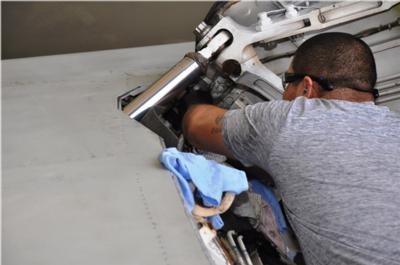Type Has Been Part Of The Fleet For More Than 50 Years
More than 50 years ago, Carrier Airborne Early Squadron (VAW) 11 onboard Naval Air Station North Island (NASNI) accepted the Navy’s first airborne early warning system aircraft: the E-2 Hawkeye (model A).

In 1965 the airframe’s first aircraft carrier deployment occurred aboard USS Kitty Hawk (CVA 63). The Hawkeye’s ability to guard against airborne threats set precedence for the protection of naval carrier battle groups that continues to this day. Introduced by the Grumman Aircraft Company in the mid-1960s, the twin turbo-propeller aircraft E-2 Hawkeye and its sister airframe, the C-2A Greyhound transport, still operate aboard naval aircraft carriers.
Production of the E-2C model began in 1973. Thirty years later the E-2C’s enhanced variant, the E-2C Hawkeye 2000, deployed aboard USS Nimitz (CVN-68).
In-depth maintenance to the E-2C and Hawkeye 2000 is handled in Building 460 at Fleet Readiness Center Southwest (FRCSW). FRCSW performs two levels of scheduled maintenance on the airframe: a light periodic maintenance interval (PMI) 1 which is done at FRCSW Site Pt Mugu and FRC Mid-Atlantic, and PMI-2, or a heavy maintenance, at NASNI. A staff of 124 comprised of 90 artisans and 34 indirect support personnel are assigned to the program. (Artisans also perform PMI procedures to the C-2A Greyhound in Building 460 and at VRC-30’s hangar at NASNI.)
During PMI-1, artisans assess the attachment points of the flight control surfaces on the body of the aircraft, the engines, and similar areas identified in the maintenance specification. Sheet metal repairs are made and worn parts replaced, but if a larger repair is needed, an in-service repair (ISR) is generated. “ISRs are wrapped up in the PMI, but are funded separately,” said John Goolsby, deputy program manager/Integrated Production Team (ITP). “We usually go to Pt Mugu about once a month for ISR work. It’s hard to give an average of them because we’ll knock out two to four ISRs per aircraft.”
Artisans have completed three PMI-1s at Pt Mugu so far this year, with two more scheduled. Though not a complete overhaul, PMI-2 is a substantial disassembly of the aircraft down to the fuselage. Artisans remove the aircraft’s wings, engines, landing gear and tail.
By using chemical or physical means, the aircraft’s corrosion preventive paint is removed and an in-depth metal assessment is performed targeting cracks, corrosion, exfoliation, missing fasteners, and any other surface anomalies. Goolsby said that PMI-2 procedures are conducted under the Critical Chain Project Management (CCPM) program. “The F-18 IPT was the first to get it and we were the second. There’s a program called `Concerto’ that helps us manage the aircraft throughput,” he said.
CCPM is a project management method that earmarks resources --- like people and equipment --- needed to complete a task in a specified amount of time. Concerto™ is a software program used to manage multiple CCPM projects. The E-2 CCPM throughput is divided into four procedures (induction, repair, assembly, testline), each with a targeted completion time. “Within the cells we have 30 days for the repair phase, from there it goes to full kitting where we make sure the wings and tail are built up, and then it goes to assembly. Under CCPM methodology we can guarantee an aircraft out in 220 days, assuming we have the materials,” Goolsby said.
The program anticipates a workload expansion when it begins induction of the E-2D variants next year. “The East Coast got the E-2Ds first, and they’re doing field events in Norfolk,” Goolsby said. “The first depot event is scheduled to be in September next year. We are the single site for all of the depot events.”
Meanwhile, FRCSW is working five PMI-2 events this year. Two are complete, two are awaiting landing gear, and the fifth, a NAVUP which typically includes avionics upgrades, should be in the painting phase by mid-July.
(Images provided with NAVAIR news release and from file)
 Airborne 04.16.24: RV Update, Affordable Flying Expo, Diamond Lil
Airborne 04.16.24: RV Update, Affordable Flying Expo, Diamond Lil ANN's Daily Aero-Term (04.20.24): Light Gun
ANN's Daily Aero-Term (04.20.24): Light Gun Aero-News: Quote of the Day (04.20.24)
Aero-News: Quote of the Day (04.20.24) Aero-News: Quote of the Day (04.21.24)
Aero-News: Quote of the Day (04.21.24) ANN's Daily Aero-Term (04.21.24): Aircraft Conflict
ANN's Daily Aero-Term (04.21.24): Aircraft Conflict



